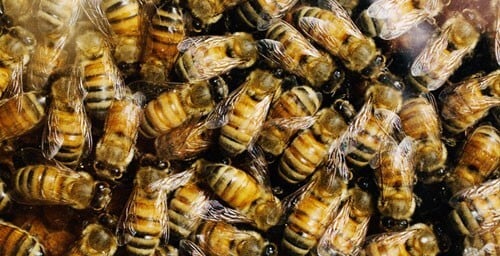Research in the wake of Colony Collapse Disorder, a mysterious malady afflicting (primarily commercial) honey bees, suggests that pests, pathogens and pesticides all play a role.
New research indicates that the honey bee diet influences the bees’ ability to withstand at least some of these assaults. Some components of the nectar and pollen grains bees collect to manufacture food to support the hive increase the expression of detoxification genes that help keep honey bees healthy.
The findings appear in the Proceedings of the National Academy of Sciences.
University of Illinois professor of entomology May Berenbaum, who led the study, said that many organisms use a group of enzymes called cytochrome P450 monooxygenases to break down foreign substances such as pesticides and compounds naturally found in plants, known as phytochemicals. However, honey bees have relatively few genes dedicated to this detoxification process compared to other insect species, she said.
“Bees feed on hundreds of different types of nectar and pollen, and are potentially exposed to thousands of different types of phytochemicals, yet they only have one-third to one-half the inventory of enzymes that break down these toxins compared to other species,” Berenbaum said.
Determining which of the 46 P450 genes in the honey bee genome are used to metabolize constituents of their natural diet and which are used to metabolize synthetic pesticides became a “tantalizing scientific question” to her research team, Berenbaum said.
“Every frame of honey (in the honey bee hive) is phytochemically different from the next frame of honey because different nectars went in to make the honey. If you don’t know what your next meal is going to be, how does your detoxification system know which enzymes to upregulate?” Berenbaum said.
Research had previously shown that eating honey turns on detoxification genes that metabolize the chemicals in honey, but the researchers wanted to identify the specific components responsible for this activity. To do this, they fed bees a mixture of sucrose and powdered sugar, called bee candy, and added different chemical components in extracts of honey. They identified p-coumaric acid as the strongest inducer of the detoxification genes.
“We found that the perfect signal, p-coumaric acid, is in everything that bees eat – it’s the monomer that goes into the macromolecule called sporopollenin, which makes up the outer wall of pollen grains. It’s a great signal that tells their systems that food is coming in, and with that food, so are potential toxins,” Berenbaum said.
Her team showed that p-coumaric acid turns on not only P450 genes, but representatives of every other type of detoxification gene in the genome. This signal can also turn on honey bee immunity genes that code for antimicrobial proteins.
According to Berenbaum, three other honey constituents were effective inducers of these detoxification enzymes. These components probably originate in the tree resins that bees use to make propolis, the “bee glue” which lines all of the cells and seals cracks within a hive.
“Propolis turns on immunity genes – it’s not just an antimicrobial caulk or glue. It may be medicinal, and in fact, people use it medicinally, too,” Berenbaum said.
Many commercial beekeepers use honey substitutes such as high-fructose corn syrup or sugar water to feed their colonies. Berenbaum believes the new research shows that honey is “a rich source of biologically active materials that truly matter to a bee.”
She hopes that future testing and development will yield honey substitutes that contain p-coumaric acid so beekeepers can enhance their bees’ ability to withstand pathogens and pesticides.
Although she doesn’t recommend that beekeepers “rush out and dump p-coumaric acid into their high fructose corn syrup,” she hopes that her team’s research can be used as the basis of future work aimed at improving bee health.
“If I were a beekeeper, I would at least try to give them some honey year-round,” Berenbaum said, “because if you look at the evolutionary history of Apis mellifera, this species did not evolve with high fructose corn syrup. It is clear that honey bees are highly adapted to consuming honey as part of their diet.”


